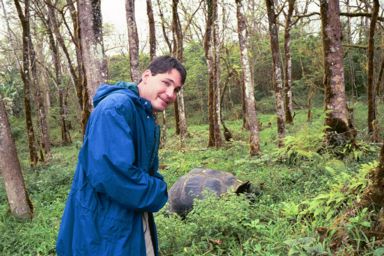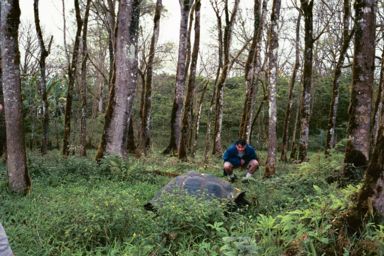November 5, 2002, 10:18 pm 30.45" Hg, 73.0 F
This morning required a very early wake-up, as at about 7:45 there was an
announcement that divers should be ready to depart in ten minutes. I had
forgotten when we were to leave. I leapt out of bed, quickly got dressed,
assembled everything in my knapsack, and trotted over to reception to
depart. Seeing no one there, I ran up to the dining area for a quick
breakfast snack. Then the three of us (Jeff, Marla, and myself) were
ferried over to the quay at Puerto Ayora on the wouthwest edge of the
island of Santa Cruz.
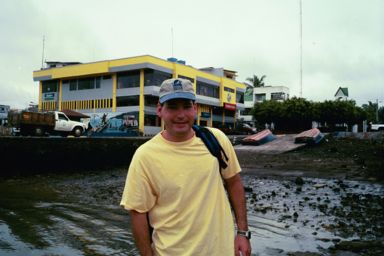
Puerto Ayora, a town of 20,000
There the divemaster from yesterday, Luis, met us,
and we were driven along with Cassia, a woman from Sao Paolo, Brazil, along
for the diving, across the island to the channel between Santa Cruz and
Baltra. We loaded up the dive boad (they loaded - we watched) at a ferry
disemberkation location. We steamed twenty minutes to Daphne Minor, a
volcanic mount off the north shore of Santa Cruz.
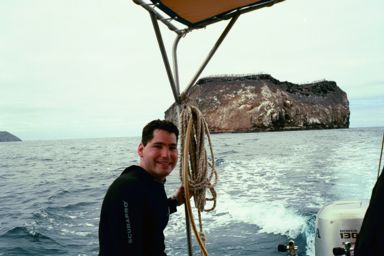 Daphne Minor
Daphne Minor
|
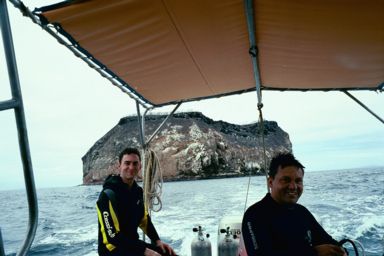 Jeff and our divemaster Luis
Jeff and our divemaster Luis
|
This dive was a wall
dive, as the volcanic mount rises from a bottom over 100 feet below. It was
a great dive; we saw a ten inch seahorse, two grey and one brown moray
eels, some bumphead parrotfish, and many colorful nudebranches. Cassia,
along the way, gave some pointers on breathing more slowly to increase
bottom time. She walks, cycles, and practices yoga in Brazil to improve
here diving.
When I started to run low on air, the divemaster, Luis, gave me his octopus
regulator to breath on. Although I gained an extra five minutes, I missed
the large octopus that Luis and Cassia saw just after I left them to go up
for a safety stop at fifteen feet!
We then had cookies and crackers on the boat, as we had na hour surface
time before our next dive. The next one was on North Seymour, just below
some rocky cliffs.
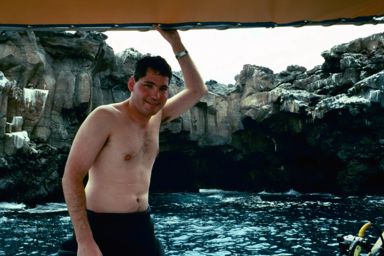
The cliffs of North Seymour
I lasted fifty minutes for this dive - a happy improvement. We found a
sleeping sea turtle in a crevice, a tiger snake eeel, a black spotted moray
and many sharks. Many sharks! At first we saw four white tipped reef sharks
in a small cave, a few of which darted out. A bit further on we saw five
more and we settled to the bottom, gripping some coral to avoid flopping
about in the stroing surge, and watched them circle about feeding. We spent
over fice minutes watching these sharks, like a Jaques Cousteau special,
circling about feeding. They swam with their mouths open and occasionally
snapped their jaws shut. After return to the boat we forwent our
Polaris box lunches for some good rice, mashed yuca, and cold
chicken in a cream sauce. It was very good. What was special was that the
sun broke out as we were returning to the boat - the balance of the day
featured a greay sky.
After piling into "My Friend", the pickup truck which had brought us over,
we chatted as we drove south until we turned off on a dirt side road whose
condition was reminiscent of wilderness area fire roads in California. We
drove down this for half a mile until we were stopped by a blue and white
bus in front of us. This bus blocking our progress turned out to full of
Polaris passengers, including Marla's mother and Jeff's wife, so we
joined them and the naturalist Fernanda, and walked down a trail into some
green fields. We wore boots and windbreakers for it was grey and damp. Here
and there in the grass were to been grayish lumps, like boulders. However,
a closer approach revealed to one that these boulders had legs. We were
seeing dozens of Galapagos tortoises in the wild.
Self propelled boulders, AKA Santa Cruz land tortoises
This sub-specias was the Santa Cruz variety. Fernanda explained that the
fields were of a farmer, and I spotted a cow pattie. Fernanda said that the
cows and tortoises could co-exist peacably. Although the barbed wire fences
delimiting these fields may have corralled the cows, from the scratches on
the tortoises' shells I presume the tortoises were not so similarly
constrained.
After this, the three of us, Cassia, and our divemaster Luis were dropped
at the Charles Darwin Research
station, which has an exhibit about the giant Galapagos tortoise and
conducts tortoise breeding programs, releasing young into the wild when thy
are large/old enough to resist preadtors (other than hungry pirates). Then
the three of us walked through town (Puerto Ayora) souvenir shopping along
the way.
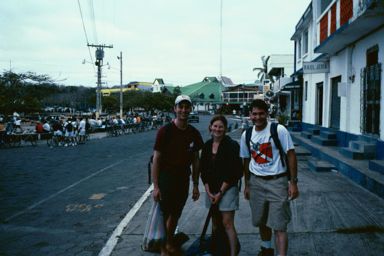
Jeff, Marla, and myself in Puerto Ayora
I bought my obligatory postcards and a coffee mug with an iguana to add to
my collection at work which illustrates all the places I've been. An
uneventful zodiac ride back to the Polaris, dinner, and an
Ecuadorean band played Andean music which sounded very much like the music
of Panchamam, show cassette I bought in Strasbourg in the summer of 1986.
During the zodiac ride I learned why they call the zodiac "panga". Years ago
small boats were made in Ecuador from a hollowed felled tree. Thus
all small boats (not just zodiacs) came to be called pangas. In town
Jeff wanted a small wood carved iguana, so the three of us went in every
shop a searching...
November 6, 2002 9:28 pm


 Daphne Minor
Daphne Minor
 Jeff and our divemaster Luis
Jeff and our divemaster Luis

